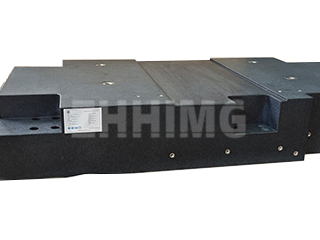In the world of ultra-precision metrology, the granite measuring tool is not just a heavy block of stone; it is the fundamental standard against which all other measurements are judged. The final dimensional accuracy—achieved in the micron and sub-micron range—starts long before the final, meticulous lapping process. But what initial processes truly set the stage for such unparalleled precision? It begins with two critical, foundational stages: the rigorous selection of the raw granite material and the high-precision cutting process used to shape it.
The Art and Science of Material Selection
Not all granite is created equal, particularly when the end product must serve as a stable, reference-grade measuring tool like a surface plate, tri-square, or straight edge. The selection process is deeply scientific, focusing on inherent physical properties that guarantee dimensional stability over decades.
We specifically seek out high-density black granite varieties. The color indicates a higher concentration of dense, dark minerals, such as hornblende, and a finer grain structure. This composition is non-negotiable for precision work for several key reasons. Firstly, Low Porosity and High Density are paramount: a tight, fine-grained structure minimizes internal voids and maximizes density, which directly translates to superior internal damping characteristics. This high damping capacity is essential for rapidly absorbing machine vibrations, ensuring the measuring environment remains utterly stable. Secondly, the material must exhibit an extremely Low Coefficient of Thermal Expansion (COE). This property is crucial, as it minimizes expansion or contraction with typical temperature fluctuations in a quality control environment, guaranteeing the tool maintains its dimensional integrity. Finally, the selected granite must possess high compressive strength and a Uniform Mineral Distribution. This uniformity ensures that the material responds predictably during the subsequent cutting and, more importantly, the critical manual lapping stage, allowing us to achieve and hold our demanding flatness tolerances.
The High-Precision Cutting Process
Once the ideal raw block is extracted from the quarry, the initial shaping phase—the cutting—is a sophisticated industrial process designed to minimize material stress and set the stage for ultra-precision finishing. Standard masonry cutting methods are simply insufficient; precision granite demands specialized tooling.
The current state-of-the-art technique for large-scale granite block cutting is the Diamond Wire Saw. This method replaces traditional circular blades with a continuous loop of high-strength steel cable embedded with industrial diamonds. The use of this method offers distinct advantages: it ensures Reduced Stress and Heat because the diamond wire saw operates in a continuous, multi-directional motion, which distributes the cutting forces evenly across the material. This minimizes the risk of introducing residual stress or micro-cracks into the granite—a common danger with single-pass, high-impact cutting methods. Crucially, the process is typically wet, utilizing a constant stream of water to cool the wire and flush away granite dust, thereby preventing localized thermal damage that could compromise the material’s long-term stability. This technique further allows for Efficiency and Scale, enabling the precise shaping of massive blocks—required for large-format granite surface plates or machine bases—with unprecedented control, providing a precise starting geometry that significantly reduces the time and material waste involved in the subsequent rough grinding stages.
By focusing relentlessly on the selection of the finest dense, stable material and implementing advanced, stress-minimizing cutting techniques, we ensure that every ZHHIMG granite measuring tool is manufactured with the inherent quality required for the world’s most precise dimensional measurements. The meticulous lapping that follows is only the final act in a carefully engineered production process.
Post time: Oct-24-2025

